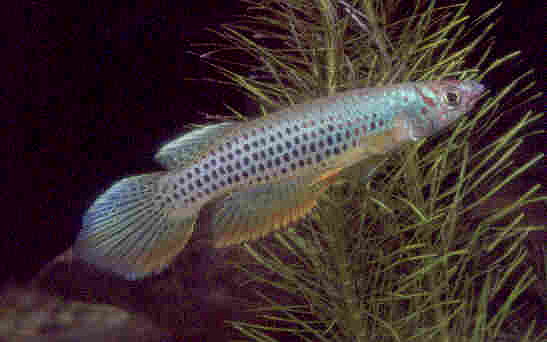Epiplatys esekanus Scheel 1968

E.esekanus
collected from the type locality location. Wild fish.
Photo courtesy of Ed Pürzl.
| Meaning of Name |
After Eséka, near the type locality. |
| First Description |
Scheel J.J. 1968. Rivulins of the Old World. TFH Publications: p 187-187, 454-455, figures. |
| Size |
6.5 cm |
| Meristics |
|
| Karyotype |
n = 21, A= 25 (Scheel 1990) |
| Sub-Genus |
|
| Group |
sexfasciatus |
| Synonyms |
|
Populations
|
Boumnyebel - Collected by Horst Gresens in 2009 & brought back to Germany where it was reproduced in large numbers.
|
| Type Locality |
A brook 15 miles north of Eséka close
to the road junction of the Eséka - Jaunde - Edéa roads,
eastern Cameroon. |
| Distribution |
Limited to the area of the type locality & brooks of the Kélé River drainage (north of Eséka. The area is situated at the base of a range of hills seperating the coastal lowland from the inland plateau. http://homepage.uibk.ac.at/homepage/c102/c102mr/epiplaty/esekanus.htm |
| Habitat |
|
| Distinguishing Characteristics | Anal fin is quite distinct with an outer margin of black, a submarginal band of yellow with another band of orange inside this. The population from M'banga has a submarginal band of orange only in the photos I've seen but the fin is still distinctive. These markings are also seen in the pectorals & lower caudal fins. |
| Colour/Pattern Variability | Low |
| History |
Caught originally at the type locality. The holotype (a small male is deposited in the Copenhagen Zoological Museum. Collected along with A.loennbergii
by Legros, Vlum & Eberl 14th July 1989 near Ndoupé,
a few kms east of Pouma (C89 / 29). |
| Breeding Notes |
Reportedly a difficult species to breed. Eggs
are laid near the surface on mops or plants. Eggs should be taken out
& stored either in water or on a bed of damp peat. Reports suggest
they can be sensitive to fungus. Water incubation takes 14-16 days.
Sexual maturity takes around 7 months. A slow growing species. |
| Diameter of Egg | |
| Remarks |
|